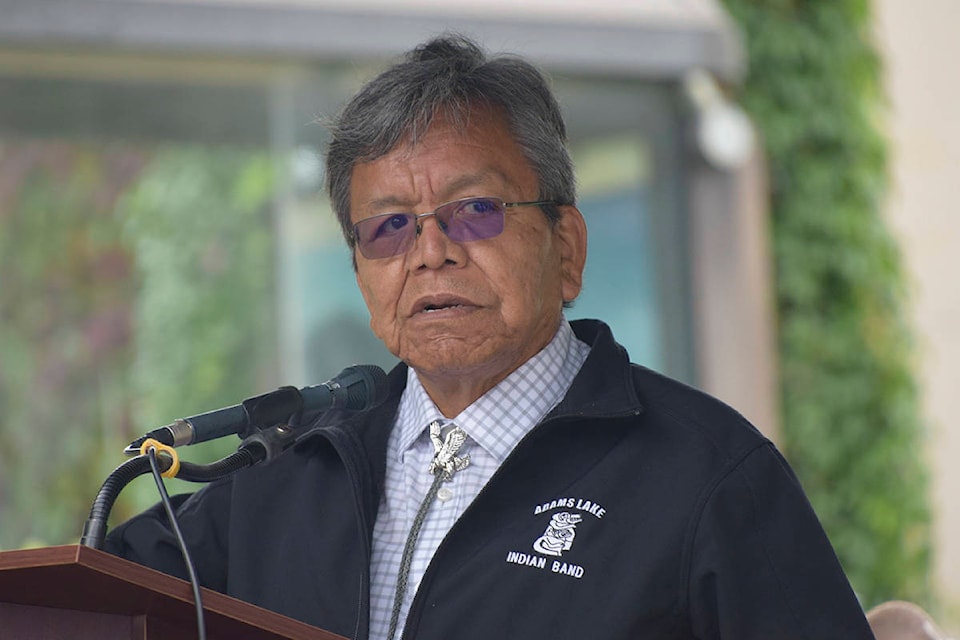The chief of the Adams Lake band remembers stories of the Upper Adams River early summer run containing sockeye salmon weighing 20, 30 and 40 pounds.
“They were so numerous you could walk across the river on their backs,” Kukpi7 (Chief) Cliff Arnouse recounted.
It’s memories of what once was that helped spark a pet project of his, a salmon restoration program on Adams Lake.
“The salmon that returned to the Upper Adams River and Adams sustained our community for thousands of years and it is imperative that we see this run returned to its former glory,” he said.
Adams Lake is now very low in nutrients, classified as an ‘ultra-oligotrophic’ lake.
“This ultra-oligotrophic classification is consistent with the collapse of the Upper Adams River sockeye run over a century ago, as the lake no longer receives the input of marine-derived nutrients on an annual basis to sustain its historical productivity,” stated a news release from the band.
With not enough fish coming back to die and creating nutrients, there’s not enough nourishment to help the small fry survive in the lake, Arnouse said. He said logging and splash dams destroyed a lot of salmon eggs and stirred up silt over the years.
Read more: Adams River Salmon Society seeks to bar wading trout anglers from Shuswap park
Read more: Paying tribute to a primeval passage
The band has been requesting action and negotiating with the federal government for some time, he said, so the project is a welcome one. It comes from a proposal submitted by Arnouse.
Nutrients, in the form of agricultural grade liquid fertilizer, will be applied to the lake using a boat to assist in restoring historical lake productivity and rebuilding early summer run sockeye escapement.
Fertilizer additions will start in mid-April, 2021, and be applied weekly in a designated treatment area of the lake until late August. The four-year program began on April 1, 2020 with an extensive one-year lake pre-fertilization monitoring program.
The data from this year’s monitoring will be used as a baseline for the future work to be completed on the program.
Arnouse gave credit to the Okanagan Nation, who Adams Lake partnered with, as it has experience in the fertilization and enhancement of fish habitat in Okanagan Lake.
“They helped us out and will probably keep helping.”
Read more: Scientific experts say fish virus poses low risk to Fraser River sockeye
Read more: Shuswap hisstory in pictures - Salmon run
The goal of the project is to support Secwépemc leadership in the restoration of the Upper Adams early summer run sockeye to a sustainable level and improve opportunities for sustainable use, stated the release.
“The sustainability of this culturally and ecologically important species hinges on our ability to listen, work together and apply innovative techniques to increase wild sockeye salmon production in B.C.,” said Fin Donnelly, B.C. parliamentary secretary for Fisheries and Aquaculture. “I thank Kukpi7 Cliff Arnouse and the Adams Lake Indian Band for implementing this important project and look forward to monitoring its progress over the next four years.”
Arnouse said it will take a long time to educate everyone up and down the Fraser to understand what the band is trying to do to restore the early run, but it will be beneficial to everyone.
“Salmon is one of our most sacred foods, it sustains us and it also ties us all together…”
Project Partners include B.C.’s Ministry of Agriculture, Food and Fisheries; Ministry of Environment and Climate Change; Secwépemc Fisheries Commission; Okanagan Nation Alliance; and Fisheries and Oceans Canada. Funding is supplied through the British Columbia Salmon Restoration and Innovation Fund, a joint federal-provincial fund.
marthawickett@saobserver.net
Like us on Facebook and follow us on Twitter
